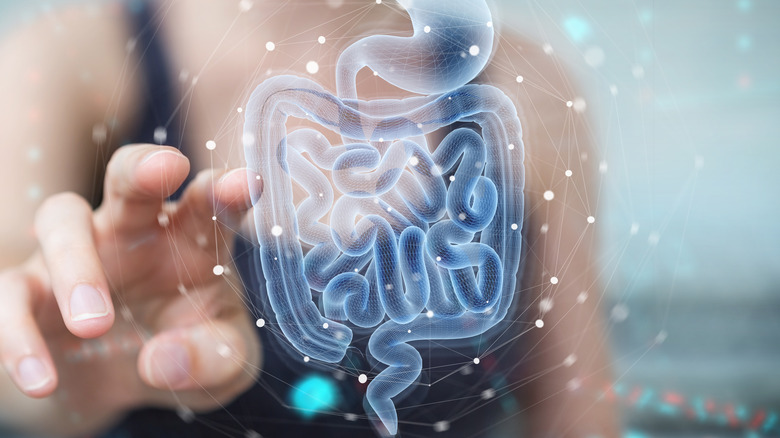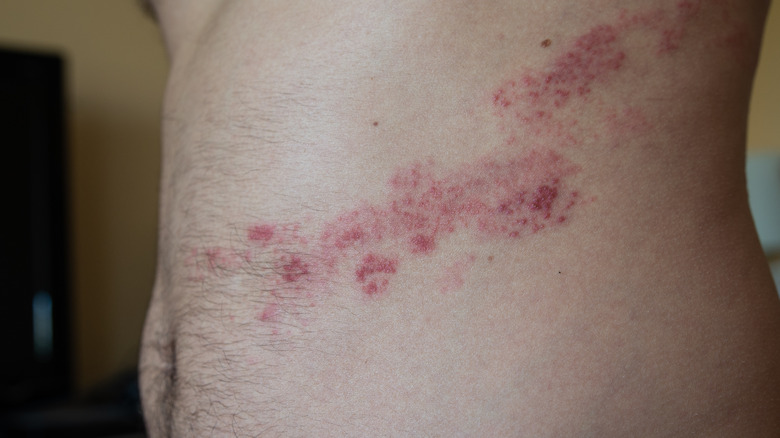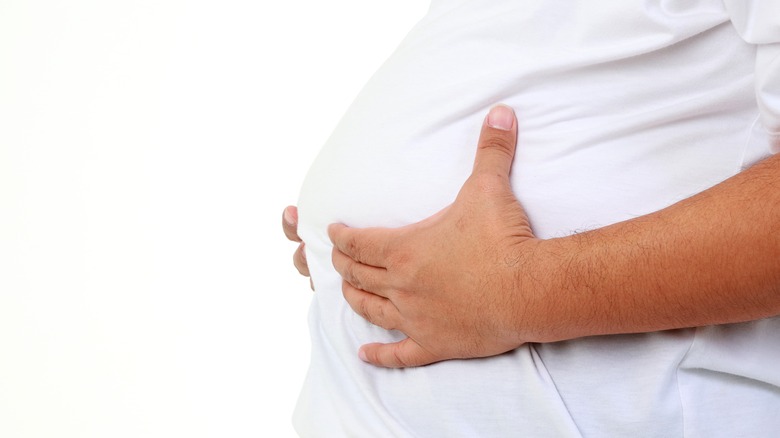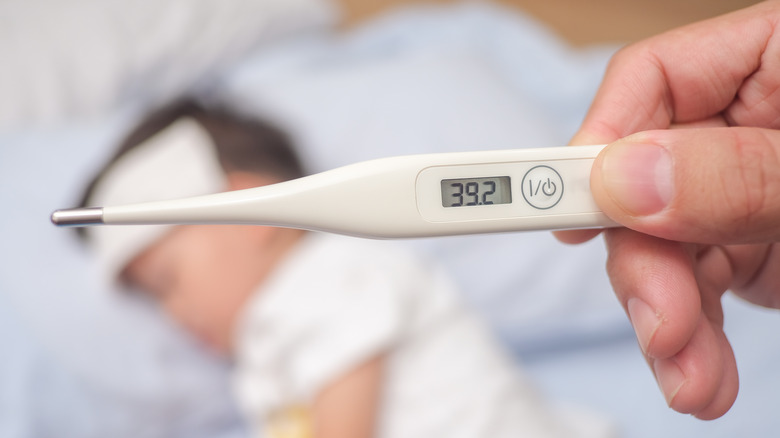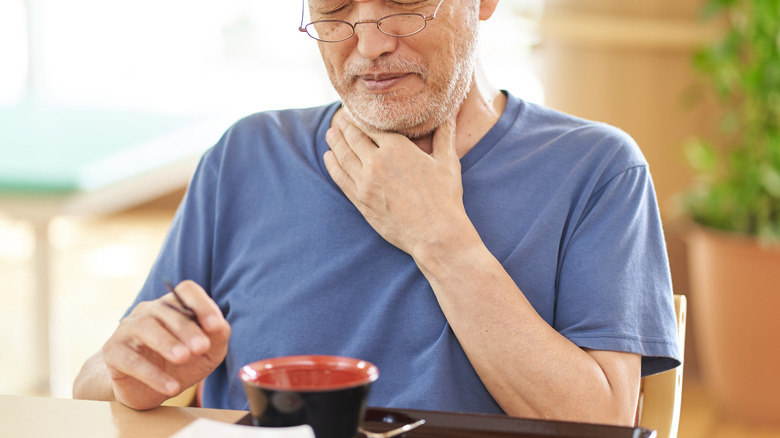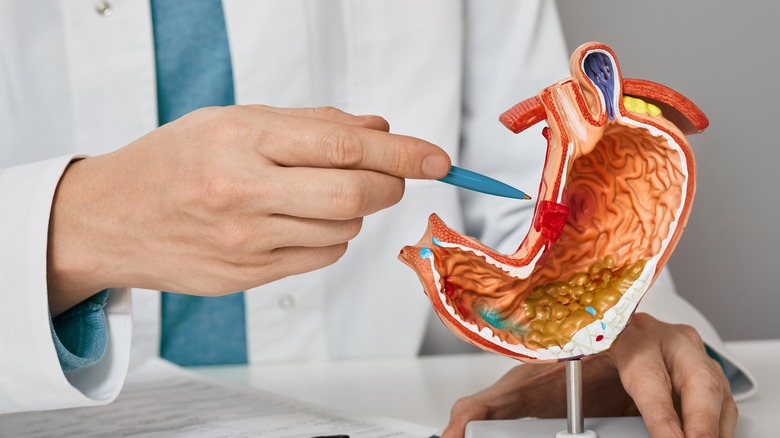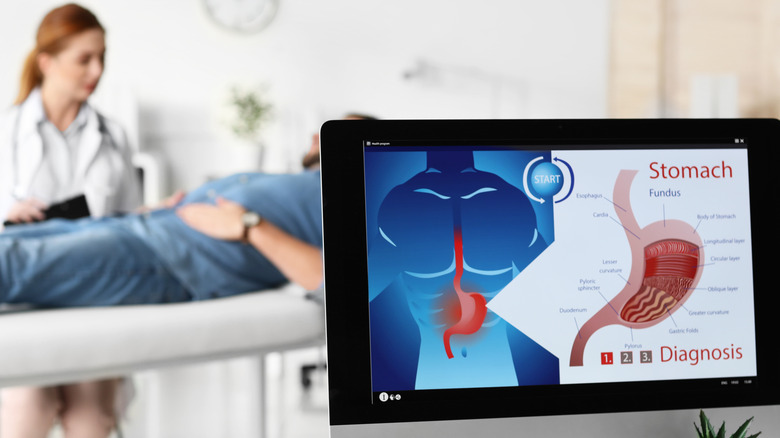Warning Signs From Your Stomach You Shouldn't Ignore
It can be easy not to take stomachaches seriously. After all, they are a common part of everyday life. Thus, it's important to be able to differentiate run-of-the-mill stomach pain from something more sinister like an infection, gallstones, or even cancer.
One key point involves deciding whether your symptoms are due to an upper (esophagus, stomach, and small intestines) or lower (the colon, rectum and anus) gastrointestinal (GI) problem. Dr. Jonathan Gotfried of Temple University's Lewis Katz School of Medicine explains via Merck Manual that upper GI symptoms tend to include things like indigestion (dyspepsia), nausea and vomiting, chest pain, and inability to swallow normally. Meanwhile, lower GI symptoms tend to include diarrhea, constipation, gas, bloating, rectal pain and rectal bleeding. If any of these symptoms are present, chances are your stomach isn't responsible.
Here's a look at the basic anatomy and physiology of the stomach and upper GI tract, as well as an exploration of the red flag symptoms that should be brought to a medical professional immediately.
Abdominal anatomy
In colloquial use, the term "stomach" typically refers to the abdomen (via MedlinePlus). Therefore, the cause of a stomachache may originate in an adjacent organ, and not the stomach itself.
According to an article in the journal Current Opinion in Supportive and Palliative Care, a "stomachache" may actually not involve the stomach. The generalized discomfort or ache in we can feel deep in the abdomen is known as visceral pain. This type of pain can be a sign of a problem in abdominal organs like the stomach, gallbladder, and intestines. On the contrary, when somebody jams a finger or sprains an ankle, the pain tends to be specific to the area affected. That is because the nerves in skin and soft tissue are much more sensitive than those innervating internal organs. This makes sense, as the pain response notifies the brain of impending danger.
The skin, muscle and bone (which are more likely to be affected by outside forces) send more finely calibrated pain sensations to the brain, compelling us to quickly stop the offending activity. However, if something is irritating the nerves in the abdomen, it is less important to send a specific impulse from a specific organ, simply because any damage to an internal organ is a serious problem fr the brain. It isn't as important to identify the specific location. This is why visceral pain is so unique.
Skin abnormalities
Pancreatitis is a relatively common cause of severe stomach pain, often described as boring a hole to the back (via the Mayo Clinic). Chronic alcohol abuse can be a risk factor for developing the disease, a case study in The Lancet notes. But pancreatitis often presents with a characteristic change to the skin of the abdomen. Cullen's and Grey-Turner's signs describe a pattern of bruising around the belly button and on both flanks, respectively. The Lancet explains that these bruises commonly occur from intra-abdominal bleeding, most commonly in pancreatitis but can be found in some other conditions too.
Shingles may also present with pain in the region of the stomach. The CDC says that sometimes, the pain develops days before its signature rash develops. Other symptoms of shingles include "fever, headache, chills [and] upset stomach." Shingles occurs when the chicken pox virus (yes, the same one from childhood) is reactivated. Turns out, the virus—called herpes zoster—never really leaves us. Instead, it lies dormant in the roots of spinal nerves. These nerves line the chest and abdomen in horizontal stripes. So when shingles occurs, a painful rash develops along the nerve's distribution. Because of this, the CDC says, the pain and rash from shingles tends to appear in the same band as the infected nerve.
Interestingly, because the nerves do not cross the midline of the abdomen, neither do symptoms of shingles.
Distension
Some stomach bloating is a part of everyday life. But, if the bloating doesn't go away and is visibly worsening, it may be time to visit a medical provider. That is because abdominal distension may be a sign of impaired liver function.
According to the American College of Gastroenterology (ACG), this can lead to an abnormal accumulation of fluid in the belly called ascites. The presence of ascites in the abdominal cavity puts pressure on the organs, nerves, and vascular tissue within, leading to a sense of fullness and discomfort. Weight gain associated with bloating may offer another diagnostic clue; if the body is unable to clear the fluid through the urinary system extra pounds can quickly rise.
Ascites is generally a sign of poor liver function, most commonly due to liver scarring called cirrhosis. However, other conditions such as heart failure, kidney failure, or cancer can also spur its arrival. Ascites itself can be treated through a variety of measures, but an important first step is to reduce sodium intake to less-than 2,000 milligrams per day. This can actually be quite challenging for even the healthiest of diets, so medication will likely be required, per the ACG. Diuretic medications may be prescribed or direct drainage with a needle may be advised.
Abdominal pain with fever
It can be difficult to delineate the pain of simple indigestion from more serious stomach issues. This is why clinicians use vital signs when initially evaluating a patient, according to Johns Hopkins Medicine. If vital signs are within normal limits, you can be confident that the body is compensating for whatever is causing pain. However, if abdominal pain is accompanied by a fever, it becomes more important to identify the specific cause. This, paired with the location of the pain, can give a clinician many clues about what may be occurring in your belly, per the National Institute of Child Health and Human Development.
According to a study published by the American Academy of Family Physicians, sudden pain in the lower left part of the abdomen, in conjunction with a fever, suggests a condition called diverticulitis. This condition occurs when pockets on the colon, called diverticula, become inflamed and infected. In up to 10% of the population under 45 years old, the colon is pocked with small diverticula which never become symptomatic. For a small percentage, diverticulitis will develop.
The study says that diverticulitis is the most common cause of left lower abdominal pain, and a triad of symptoms — left lower quadrant pain, fever, and increased white blood cell count — is highly suggestive. If left untreated, diverticula may rupture and spill infectious contents into the abdomen. Treatment may consist of antibiotics, and sometimes surgery.
Recurrent indigestion
According to an article by Dr. Jonathan Gotfried in Merck Manual, a single instance of indigestion-like symptoms may be cause for alarm. That is because heart disease and heart attacks commonly manifest masquerading as an upset stomach. But if indigestion is a chronic problem, you're not quite out of the water, either. Dr. Gotfried advises a visit to a medical professional for an evaluation.
Chronic symptoms of indigestion can indicate the presence of a gastric ulcer. Indigestion from an ulcer has some defining characteristics. Dr. Gotfried says, "Ulcer-like symptoms consist of pain that is localized in the epigastrium, frequently occurs before meals, and is partially relieved by food, antacids, or H2 blockers." Gastric ulcers are commonly caused by H. pylori infection of the stomach lining or excess intake of NSAIDs like ibuprofen.
Dr. Gotfried explains that other causes of recurrent indigestion include a slow GI system (called dysmotility) or acid reflex. Symptoms of dysmotility tend to include early fullness, nausea, vomiting, and are worse after eating. Reflux, however, typically manifests with indigestion, burning and regurgitation.
Recurrent abdominal pain
An occasional stomachache is an uncomfortable reality of human life. And some weeks, even, can be better than others. But according to Dr. Jonathan Gotfried, if abdominal pain persists either constantly or intermittently for 3 months or longer, it is classified as recurrent abdominal pain and it shouldn't be ignored. The differential diagnosis for chronic abdominal pain is vast, including cancers of many varieties, chronic hepatitis, food allergies, Chron disease, ulcerative colitis and IBS. Interestingly, cannabis use can lead to persistent nausea and vomiting that is "relieved with a hot shower or marijuana cessation."
However, functional bowel disorders like irritable bowel disorder are very common causes of chronic abdominal pain. And the diagnosis of IBS is often a long road, Gotried notes: "Nearly all patients with [chronic abdominal pain] have had a prior medical evaluation that did not yield a diagnosis after history, physical, and basic testing."
Thus, if a stomachache just won't leave you alone, even for months on end, it is wise to start the journey to identifying the problem early. Early diagnosis means early treatment — and ultimately, faster control of symptoms.
Inability to swallow normally
Picture this: You eat too much, and a while later, you experience some regurgitation of your stomach's contents. Not a full-blown vomit, but definitely uncomfortable. This is normal. Perhaps you are drinking water, and a drop finds its way into the trachea instead of the esophagus. The lungs get irritated, you cough. Annoying, but also normal.
However, the inability to physically swallow food or water is called dysphagia — and may indicate a serious problem.
In an article in the journal Missouri Medicine, Dr. Prianka Chilukuri, et al. write, "Dysphagia is an alarm symptom and is not a part of normal aging." The inability to swallow is an important symptom in many esophageal and stomach disorders, but cancer is among the most serious. Chilkuri, et al. mention that dysphagia is a symptom of both esophageal and upper stomach cancer. Because of this, they mention that, "In patients with rapidly progressive dysphagia, weight loss, and anorexia, [cancer] should be considered until proven otherwise." Additionally, esophageal cancer is expected to increase over 10 years, based on current data.
Blood in vomit
The presence of blood in the vomit brings a whole new level of worry to an already concerning situation. Typically, the blood in vomit indicates that a vascular structure has sprung a leak somewhere along the upper GI tract. Writing for StatPearls, authors Catiele Antunes and Eddie Copelin II illustrate the night mortality rate of upper GI bleeds, with a mortality rate ranging from 2 to 15 percent. Moreover, this problem is relatively common, with a case prevalence between 80 and 150 per 100,000 people.
There are multiple reasons why a bleed may occur, but gastric and duodenal ulcers, which develop as a result of peptic ulcer disease, are among the most common reasons for upper GI bleeding. Peptic ulcer disease is estimated to be responsible for around 50% of all upper GI bleeds. However, other causes include esophagitis, dilated veins (called varices), and Mallory-Weiss tear.
Evaluation may include upper endoscopy to locate the bleed, and blood transfusion may be necessary for severe bleeds.
Vomiting after eating certain foods
Spoiled or contaminated food will make anybody sick. But vomiting after eating freshly cooked food is abnormal. In these situations, clinicians may begin asking if there is a pattern to your symptoms. For instance, are you vomiting after ingestion of a known food allergen? If so, your own immune system is likely responsible.
One common cause of this is celiac disease. The Celiac Disease Foundation explains that celiac disease is an autoimmune disorder in which our own immune cells attack the fiber-like bands of tissue (called microvilli) that line the intestines. The attacks only occur after exposure to gluten containing foods, such as wheat flour.
When vomiting occurs, it is important to do a bit of investigatory work, the information you collect could help elicit a diagnosis. If you notice that wheat containing foods seem to be involved with each episode, a visit to your PCP might be indicated for evaluation of celiac disease.
In addition to GI upset, people with celiac disease experience signs of malnutrition such as unexplained weight loss and fatigue (via the Celiac Disease Foundation). This occurs because celiac disease damages the lining of the GI tract, which leads to a decrease in the absorption of essential nutrients.
Recurrent vomiting
There are few curses worse than persistent vomiting. Yet for some Americans, unexplained and recurrent bouts of vomiting are a part of everyday life, according to the Mayo Clinic. This condition is called cyclic vomiting syndrome, and its cause is unknown at this time. However, some specific triggers include emotional stress, anxiety, common cold, intense exercise, and menstruation.
The key to treatment involves identifying triggers and implementing lifestyle changes to avoid them. The diagnosis of this condition is Mallory-Weiss, as there is no specific test or imaging study that unmistakably points to cyclic vomiting syndrome. Instead, clinicians rule out other causes of vomiting and make the diagnosis by exclusion.
This condition can be dangerous, because vomiting can lead to dehydration, metabolic disturbances and electrolyte abnormalities. So if you or a loved one is experiencing seemingly unexplainable bouts of vomiting, consider talking with a medical professional about cyclic vomiting syndrome.
Stomachache after fat-rich meals
We tend to think our stomach occupies most of the space along the midline above the belly button. However, several critical structures find their home in the same area, including the pancreas, liver and bile ducts. Because of this, Dr. Megan Soliman (for Healthline) says gallstones should be considered in cases of "dull pain in the middle to upper right area of the abdomen." This type of pain, characteristically appearing after fat-rich meals, is called biliary colic.
Biliary colic occurs when a stone in the gallbladder obstructs the organ's outlet to the common bile duct. The gallbladder sits just below the liver and serves as a reservoir for bile produced in the liver. Bile is important in digesting fat. When fat is sensed in the intestines, the gallbladder squeezes in order to expel bile. If a stone is blocking this outlet, pain can occur. Because the innervation of organs like the gallbladder and liver aren't quite as sensitive as those in skin, this dull pain is often felt in the right upper quadrant or in the midline.
Dark, tarry stools
Transient changes in stool consistency or color can be just a normal part of life. For instance, beets reliably turn the stool red. Unsurprisingly, it can be a frightening experience to see blood-colored stool in the toilet.
But the presence of blood in the stool is more likely to be indicated by either bright red color or very dark, tarry stools. These are called hematochezia and melena, respectively, according to Dodd Wilson's medical text published in Clinical Methods. As Wilson explains, "Melena is the passage of black, tarry stools. Hematochezia is the passage of fresh blood per anus, usually in or with stools."
So, why would stool turn dark and sticky? If bleeding occurs higher up in the GI system, such as in the stomach, that blood will lose its red color and instead turn profoundly dark. Wilson warns clinicians to thoroughly explain to their patients what "jet black" means in this context by "comparing the stool color to a black object." This is the result of the intestines doing their best to digest the blood being leaked into the system. Wilson adds that melenic stools "also have a stickiness that the patient often remembers."


